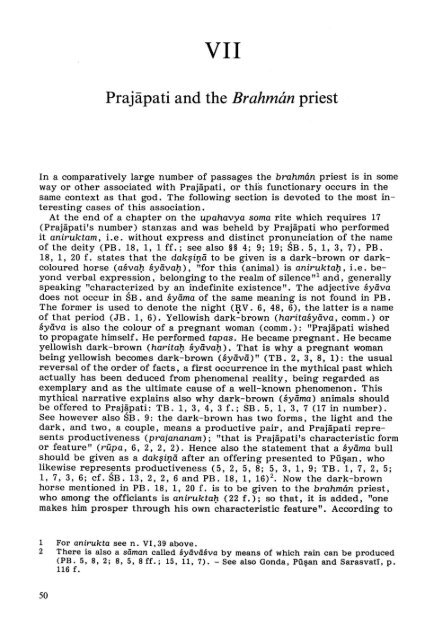Prajapati's relations with Brahman, Brhaspati and Brahma - DWC
Prajapati's relations with Brahman, Brhaspati and Brahma - DWC
Prajapati's relations with Brahman, Brhaspati and Brahma - DWC
Create successful ePaper yourself
Turn your PDF publications into a flip-book with our unique Google optimized e-Paper software.
VII<br />
Prajapati <strong>and</strong> the Brahmán priest<br />
In a comparatively large number of passages the brahmán priest is in some<br />
way or other associated <strong>with</strong> Prajäpati, or this functionary occurs in the<br />
same context as that god. The following section is devoted to the most interesting<br />
cases of this association.<br />
At the end of a chapter on the upahavya soma rite which requires 17<br />
(Prajäpati's number) stanzas <strong>and</strong> was beheld by Prajäpati who performed<br />
it aniruktam , i.e. <strong>with</strong>out express <strong>and</strong> distinct pronunciation of the name<br />
of the deity (PB. 18, 1, 1 ff.; see also §§ 4; 9; 19; SB. 5, 1, 3, 7), PB.<br />
18, 1, 20 f. states that the dak?ir;tä to be given is a dark-brown or darkcoloured<br />
horse (asva~ syäva~), "for this (anima!) is anirukta~, i.e. beyond<br />
verbal expression , belonging to the realm of silence ,,1 <strong>and</strong>, generally<br />
speaking "characterized by an indefinite existence". The adjective syäva<br />
does not oCÇ!ur in SB. <strong>and</strong> syäma of the same meaning is not found in PB.<br />
The former is used to denote the night (~V. 6, 48, 6), the latter is a name<br />
of that period (JB. 1,6). Yellowish dark-brown (haritasyäva, comm.) or<br />
syäva is also the colour of a pregnant woman (comm.): "Prajäpati wished<br />
to propagate himself. He performed tapas. He became pregnant. He became<br />
yellowish dark-brown (harita~ syäva~). That is why a pregnant woman<br />
being yellowish becomes dark-brown (syävä)" (TB. 2, 3, 8, 1): the usual<br />
reversal of the order of facts, a first occurrence in the mythical past which<br />
actually has been deduced from phenomenal reality, being regarded as<br />
exemplary <strong>and</strong> as the ultimate cause of a well-known phenomenon. This<br />
mythical narrative explains also why dark-brown (syäma) animals should<br />
be offered to Prajäpati: TB. 1,3,4,3 f.; SB. 5, 1, 3, 7 (17 in number).<br />
See however also SB. 9: the dark-brown has two forms, the light <strong>and</strong> the<br />
dark, <strong>and</strong> two, a coupie, means a productive pair, <strong>and</strong> Prajäpati rep resents<br />
productiveness (prajananam); "that is Prajäpati's characteristic form<br />
or feature" (rüpa, 6, 2, 2, 2). Hence also the statement that a syäma bull<br />
should be given as a dak?ir;tä after an offering presented to Pü!?an, who<br />
likewise represents productiveness (5, 2, 5, 8; 5, 3, 1, 9; TB. 1, 7, 2, 5;<br />
1,7,3,6; cf. SB. 13, 2, 2, 6 <strong>and</strong> PB. 18, 1, 16)2. Now the dark-brown<br />
horse mentioned in PB. 18, 1, 20 f. is to be given to the brahmán priest,<br />
who among the officiants is anirukta~ (22 f . ); so that, it is added, "one<br />
makes him prosper through his own characteristic feature". According to<br />
1 For anirukta see n. VI, 39 above.<br />
2 There is a1so a säman called syäväsva by means of which rain can be produced<br />
(PB. 5, 8, 2; 8, 5, 8 ff.; 15, 11, 7). - See a1so Gonda, Pül?an <strong>and</strong> Sarasvatï, p.<br />
116f.<br />
50
















